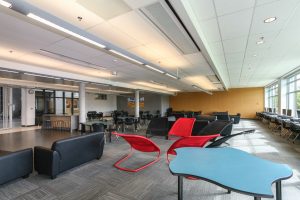
A lesson in sustainability
May 12, 2017 | By Shawn Sinnie

Steinbach Regional Secondary School in Steinbach, MB, incorporates chilled beam products as its primary source of air distribution.
Class is back in session and the teachers have a little more help this year. The renovated Steinbach Regional Secondary School in Steinbach, MB, is assisting the faculty with a great lesson for the students on the environment and the positive impact buildings can have.
Stantec Architecture and the Hanover School Division envisioned a school built to serve as a learning tool for its existing student population, as well as the growing community. The new high school serves grades 9 to 12 and offers more chances for students to learn and develop skills that will prepare them for life after high school. As a result of the renovation and new addition, the students now have the opportunity to learn real-world skills to gain employment in fields such as cosmetology, construction, power mechanics, and welding.
The sustainable design elements and the abundance of natural light now present in the school will not only teach the students about sustainability, but also help them study by providing a healthy learning environment. On top of housing the students in grades 9 to 12, the 300,000-sq. ft. facility also serves as a neighbourhood daycare.
ALIGNING WITH SUSTAINABILITY
To align with the sustainable design elements already in use, the high school incorporates chilled beam products as its primary source of air distribution. The beams feature aerodynamic properties of ceiling diffusers and benefit from the use of using hydronic coils and induced air, reducing energy consumption associated with removing sensible thermal loads.
After being discharged through nozzles located along the beams, the primary air is supplied to the beam’s mixing chamber. The nozzles inject this air into the mixing chamber at velocities capable of inducing room air through one or two coils and where it mixes with the primary supply air. This air mixture is then discharged through the ceiling slot diffusers into the space, providing high cooling outputs with low amounts of primary air. The reduced volume of air leads to smaller and less expensive air handlers and ducts, and less energy consumption.
The supplied air from the air handling unit is tempered and dehumidified to handle the latent load. The remaining loads in the space are addressed via the chilled beam’s heat exchanger. Applications with low latent cooling loads could potentially use 100 per cent outdoor air, allowing for a dedicated outdoor air system with energy recovery that would further reduce total system energy consumption.
The chilled beams used for this project can be used for both heating and cooling and are offered in multiple sizes – 12-in. and 24-in. widths and two to 10 foot lengths. They can be easily integrated into different grid styles within a suspended ceiling or in drywall ceilings. The chilled beams’ low overall height makes them ideal for reducing space required for false ceilings.
Additional air distribution products completed the HVAC system.

Natural light is an important design element in the school. Chilled beams have been easily integrated into different styles (shown here, centre foreground) within a suspended ceiling or in drywall ceilings.
THE FRESH AIR ADVANTAGE
Studies have shown that excessive noise levels can adversely affect student performance. Conventional HVAC systems typically used in schools today (fan-powered VAV, fan coils, unit ventilators), rarely meet prescribed background noise level requirements. ANSI standard S12.60 for classroom acoustics requires a maximum background noise level of 35 dBA (about NC-27) – this is difficult to attain with traditional equipment.
Furthermore, student performance is affected by space humidity and ventilation levels. HVAC systems whose primary airflow rate is modulated while the classroom is occupied often do not comply with the requirements of ASHRAE 62.1. Ventilation airflow rates are difficult to maintain at part load conditions with modulating the primary airflow rates.
Chilled beams are systems where zoned based hydronic-heating and/or cooling devices complement the conditioning of the primary air ventilation system, allowing for optimization of heating, cooling and ventilation functions and providing opportunities for savings in energy, ceiling cavity space and maintenance as well as increased occupant performance.
Most conventional HVAC systems depend on the delivery of large volumes of air to condition the classroom. Chilled beam systems typically reduce ducted air requirements by as much as 60 per cent by relying on their integral heat transfer coils to offset most of the space sensible cooling and heating requirements. Since water is more efficient for space cooling and heating than air, chilled beams use less overall energy than other options, such as VAV, VRF and fan coil units.
Since chilled beams allow classroom ducted airflow rates to be reduced to that which is required for space ventilation and latent cooling, they are suited for use with 100 per cent (DOAS) outside air systems. This allows the beams to provide a constant volume of ventilation air to the classroom at all times. Chilled beans also contribute toward achieving LEED certification.
THE END RESULT
Having opened its doors in August 2014, Steinbach is designed to meet the requirements for LEED Gold Certification. Thanks to a sustainable design and an energy efficient HVAC system, the multipurpose building serves as a daily reminder to students, teachers, and the overall community about how properly designed buildings can have a positive impact.
The Steinbach Team
Client Hanover School Division
Mechanical Westwood Mechanical Inc.
Rep Office BPL
Sales Architect Stantec Architecture Ltd.
Engineers Stantec Consulting Ltd.
Contractor Penn-Co Construction Canada
LEED Certification LEED Gold Candidate
Shawn Sinnie is marketing manager with Titus.




